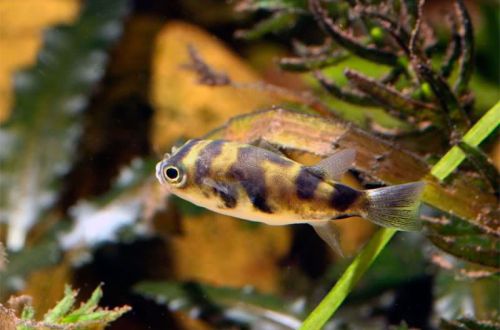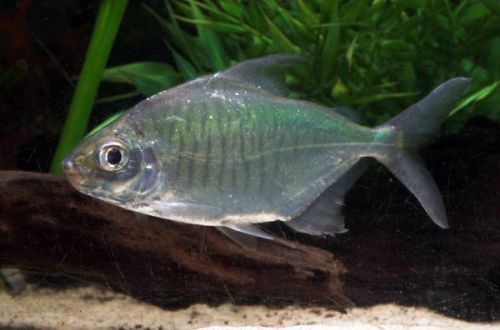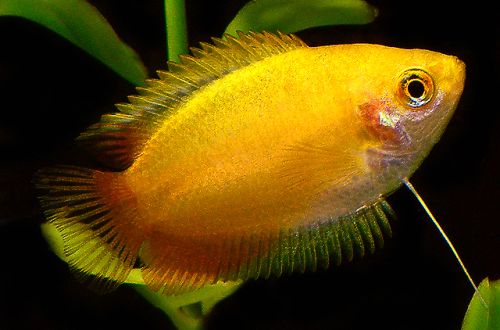
Amazonian pufferfish
Amazonian Tetraodon, Tetraodon-Donkey or Amazonian Pufferfish, scientific name Colomesus asellus, belongs to the Tetraodontiformes family. The main feature of this fish is the method of protection from predators. At the moment of danger, she draws water into herself and swells into a ball studded with needles. It is for this original “option” that many aquarists fell in love with the fish.

Contents
Habitat
It comes from South America, is found everywhere in almost the entire Amazon basin. Despite the wide habitat, the fish prefers certain places – this is the middle or lower reaches of rivers with a small current, including shallows and floodplain lakes.
Brief information:
- The volume of the aquarium – from 100 liters.
- Temperature – 20-26°C
- Value pH — 5.5–8.0
- Water hardness – soft to medium hard (2-15 dGH)
- Substrate type – any
- Lighting – subdued, moderate
- Brackish water – no
- Water movement – light or moderate
- The size of the fish is 7–8 cm.
- Food – meat
- Temperament – peaceful
- Content alone or in a group
Description
Adults reach a length of 7–8 cm. Outwardly, it looks angular until it is scared. In case of danger, the pufferfish swells like a ball and its entire surface is covered with thorns. In this case, its size increases significantly. This feature serves as a means of protection against predators, which are much more difficult to swallow such a prickly ball. In addition, they are poisonous. Coloration is golden with a white belly. There are irregularly shaped black strokes in the body drawing.
Food
The structure of the mouth resembles a beak, consisting of solid plates. They grow throughout the life of the fish, but at the same time they do not grow too large, because they wear down. In nature, they feed on crustaceans, snails, bivalve mollusks and other small living creatures with a hard shell. They can also scrape algae from the surface of stones, snags.
In a home aquarium, approximately the same foods should be present in the diet. Otherwise, the fish will have nothing to grind its beak about. Dry food (flakes, pellets) is not recommended. The only soft foods are bloodworms, brine shrimp, live or frozen.
Maintenance and care, arrangement of the aquarium
The optimal aquarium size for a small group of Amazonian tetradons starts at 100 liters. The design is not critical, the puffer fish will feel at home in any environment. However, floating plants and a few snags for shelter are welcome.
Water quality and high levels of dissolved oxygen are key. In addition to a productive filtration system, several procedures are mandatory – weekly replacement of part of the water (30–50% of the volume) with fresh water and regular removal of organic waste. You may need to purchase an additional aerator.
Behavior and Compatibility
Not aggressive, but not suitable for the general aquarium. Too active fish can frighten the Tetradon and provoke it to “bloat”. In this state, it becomes dangerous on contact. Single keeping is allowed, however, in a group, the fish feel more comfortable.
Breeding / breeding
At the time of this writing, successful breeding experiments of this species have not been recorded.
In nature, the breeding strategy is comparable to that of sea pufferfish. Unlike most freshwater Tetradons, which are highly prolific, they produce relatively few eggs.
Spawning occurs during the rainy season, when areas of tropical forests are flooded, in the substrate of which eggs are laid. Parental instincts are poorly developed; immediately after spawning, the eggs are left to themselves. The fry develop in these flooded areas in relative safety and in abundance of food. As the water recedes, they find themselves in the main channel of the rivers.
Fish diseases
Newly exported fish are prone to Ichthyophthyriasis and require long acclimatization. Fortunately, in Eastern Europe, the most common fish grown in the artificial environment of commercial farms.
In favorable conditions, health problems do not arise. However, creating their business is not easy, and, as a result, the risks are very high. This is especially true for nutrition. For example, a lack of food with a hard cover (shrimps) or a shell (snails) will lead to deformation of the bony plates of the beak. Read more about symptoms and treatments in the Aquarium Fish Diseases section.





